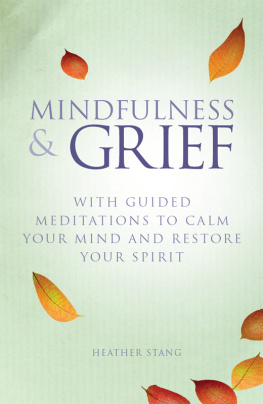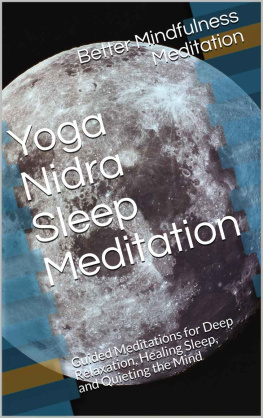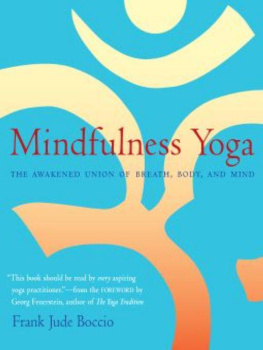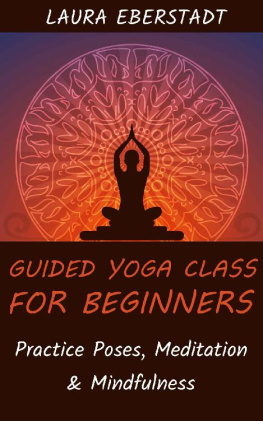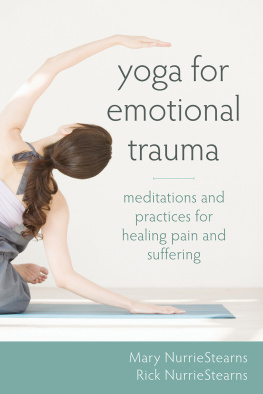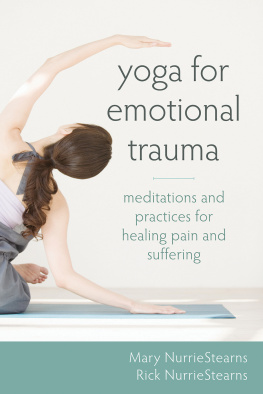MINDFULNESS
& GRIEF
MINDFULNESS
& GRIEF
WITH GUIDED
MEDITATIONS TO CALM
YOUR MIND AND RESTORE
YOUR SPIRIT
HEATHER STANG

This edition published in 2018 by CICO Books
an imprint of Ryland Peters & Small Ltd
2021 Jockeys Fields341 E 116th St
London WC1R 4BWNew York, NY 10029
www.rylandpeters.com
First published in 2014
10 9 8 7 6 5 4 3 2 1
Text Heather Stang 2014, 2018
Design CICO Books 2014, 2018
The authors moral rights have been asserted. All rights reserved. No part of this publication may be reproduced, stored in a retrieval system, or transmitted in any form or by any means, electronic, mechanical, photocopying, or otherwise, without the prior permission of the publisher.
Neither the author nor the publisher can be held responsible for any claim arising out of the use or misuse of suggestions made in this book. If you are in any doubt about your health, please consult your doctor before making any changes to your usual well-being regime.
A CIP catalog record for this book is available from the Library of Congress and the British Library.
ISBN: 978-1-78249-673-1
eISBN: 978-1-78249-782-0
Printed in China
Editor: Rosie Lewis
Designers: Emily Breen and Geoff Borin
CONTENTS
In loving memory of Don and Doug
Allow
There is no controlling life.
Try corralling a lightning bolt,
containing a tornado. Dam a
stream and it will create a new
channel. Resist, and the tide
will sweep you off your feet.
Allow, and grace will carry
you to higher ground. The only
safety lies in letting it all in
the wild with the weak; fear,
fantasies, failures and success.
When loss rips off the doors of
the heart, or sadness veils your
vision with despair, practice
becomes simply bearing the truth.
In the choice to let go of your
known way of being, the whole
world is revealed to your new eyes.
Danna Faulds, from Go In and In: Poems from the Heart of Yoga
WHY I WROTE THIS BOOK
My meditation students often ask me if I am naturally calm. The answer is no. I discovered the practice of yoga and mindfulness meditation on orders from my nurse practitioner after being diagnosed with the stress-related illness shingles. You need to do something about your stress, she said. Its making you sick. Try yoga. I took her advice, sold my web development business, and after a few years of practicing yoga and meditation under the guidance of a wonderful group of teachers, I earned my certification as a Phoenix Rising Yoga Therapy practitioner and mindfulness meditation instructor.
The better I got to know myself through mindfulness practice, the more I knew I wanted to help others reduce their suffering, so I volunteered as a call specialist on a suicide prevention hotline. My uncle Doug died by suicide when I was seven. I had felt close to him and was surprised by his deathsurprised that someone I loved would kill themselves. My natural reaction was to try to make sense of it all. As a preteen I rummaged through my grandmothers insurance files, found police reports, read books on suicide, and tried to learn everything I could about my uncles final days. As an adult, I was able to make use of that energy by helping others on the hotline. I would certainly rather have my uncle back, but given that I cannot change what happened, my ability to make meaning out of the loss by helping others has been incredibly rewarding.
I developed an eight-week Mindfulness and Grief program for my private practice while I earned my Masters degree in Thanatology (the study of death, dying, and bereavement) from Hood College in Maryland. Participants in my program have included people whose loved ones died from cancer, suicide, heart attacks, overdoses, car accidents, and murder.
I am often asked how I can bear to witness this kind of pain regularly. My answer is simple: I get to see the pain of loss change people in miraculously positive ways. Over and over again I watch people transform from complete hopelessness into the positive states of mind called the Four Brahma-Viharas: loving-kindness, compassion, sympathetic joy, and equanimity. This does not happen overnight, but it does happen, and I count myself privileged to be part of that process.
WHAT IS MINDFULNESS?
Simply put, mindfulness is the art of using your senses to be fully awake in the present moment. You may have noticed that most of your stress comes from worrying about the past or fearing the future. For many of us, nothing provokes this response more than grief.
Few of us are taught how to cope with day-to-day stress, much less grief. Fortunately, anyone can learn how to turn the stress switch to off, even during the most troubling of times. You do not need to be a Buddhist, have a background in mindfulness meditation or yoga, be physically fit, or subscribe to any particular set of spiritual beliefs to benefit from mindfulness.
The only thing you need to approach your grief mindfully is yourselfjust as you are, right now. The fact that you are reading this book shows that you have hope for your own ability to weather this storm. You will learn how mindfulness-based techniques can:
Ease the physical symptoms of grief
Calm your mind and help you to regulate difficult emotions
Improve your awareness of the present moment
Increase your compassion toward yourself and others
Help you to make meaning from your loss
Develop your new self-narrative for moving forward.
POSTTRAUMATIC GROWTH
The good news is that not only do people survive grief, but many emerge on the other side changed for the better. This phenomenon, described as posttraumatic-growth by Lawrence G. Calhoun and Richard G. Tedeschi of University of North Carolina, Charlotte, applies to any major life eventincluding griefthat challenges your emotional balance, beliefs, and personal narrative (2006).
Right now, the concept of adapting to your loss, let alone transforming your life in a positive way, may sound far-fetched. However, if you follow the mindfulness practices offered in this book, you will experience, breath by breath, a subtle but profound shift in your world view.
The reality is that when you have worked through your grief you will not be the same as you were before your loss; you will not be the same as you are now. Changes will occur with or without mindfulness in your life. While you would rather have your loved one back, and I imagine you are probably feeling a high level of distress, it may be helpful to know that on the other side of grief you may experience the following benefits:
Improved self-perception
Sense of strength
Openness to new possibilities
Improved level of compassion
Better relationships with others.
Grief, after all, is not a pathology or an illness. It is a natural part of life that causes us to experience suffering. Since the goal of mindfulness practice is the cessation of suffering, it can only make sense to bring the two together.
A key element of grief-work is reconstructing your personal story. The mindfulness practices will help you to move forward through your experience of loss while creating a continuing bond with the person you will always love.
HOW TO USE THIS BOOK
For the next eight weeks you will be introduced to a new theme in each chapter that includes supportive meditation and journaling exercises. It is suggested that you set aside 20 to 90 minutes each day to practice. There is also a daylong retreat scheduled between weeks 4 and 5. You may want to clear your schedule or arrange a day off ahead of time at this stage, if you would like to carry out the retreat.

